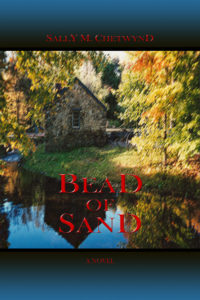Saturday, March 9, 2024
Dogs
The longer I live, the more dogs impress me. Surely, they are one of God’s greatest gifts to mankind. We humans get along well with them partly because their social structure is similar to ours. The dog owners among you likely recognized long ago that your dog does not belong to you: it’s the other way around. You belong to your dog’s pack, even when no other pack members are canines.
I’m currently reading More Scenes from the Rural Life (2013) by Verlyn Klinkenborg, an Iowan who, after living in many places around the States, has settled as a gentleman farmer in New York’s Hudson Valley. His short essays about farm life reveal relationships with not only his domestic livestock – horses, cows, pigs, chickens, ducks, geese, and dogs – but also with the wild animals that call his small farm “home” – turkeys, foxes, woodchucks, mice, deer, songbirds, and other native fauna. He delights in exploring his growing awareness and sensibilities of these other lives that inhabit his neighborhood.
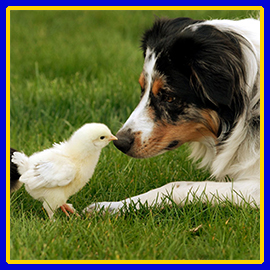
At one point, Klinkenborg refers to Vicki Hearne, author of Adam’s Task: Calling Animals by Name (1986). She was a professional dog and horse trainer. In her book, she proposes that animals that interact with humans are more intelligent than we give them credit for. She maintains that dogs and horses are “capable of developing an understanding of the good,” an actual moral code that influences their motives and actions, with behaviors reciprocal to that of their human companions.
Klinkenborg quotes Hearne here: “Dog trainers and horse trainers insist that training – teaching animals the language games of retrieving, say, or haute ecole in equestrian dressage – results in ennoblement, in the development of the animal’s character and in the development of both the animal’s and the handler’s sense of responsibility and honesty.”
Klinkenborg himself says, “Hearne … called the kinship that develops between trainers and animals a version of the heroic. She called not for mere tolerance or kindness between humans and animals but for a shared nobility. [She] explained that certain dogs and horses can teach you ‘whether or not your relationships and your artistries, your grammars, are coherent, whether what you have is a free-floating and truncated bit of the debris of Romanticism or a discipline that can renew the resources of thought.’ … No one has come close to her ability to articulate what one feels in a working relationship with animals. … It’s not a lesson we bestow on animals but a learned mystery that they impart to us.”
All this intellectual and psycho babble aside (which it may be for many), simply put, dogs teach us humans about their culture as readily as we humans teach dogs about ours. Anyone who has had a dog for a friend has had personal experiences that transcend the ordinary companionship, comfort, and amusement the dog provides.
To Tease Your Mind
Minor tragedy stalked.
My setter pup, Toby, left alone one night,
made confetti of about half of my manuscript.
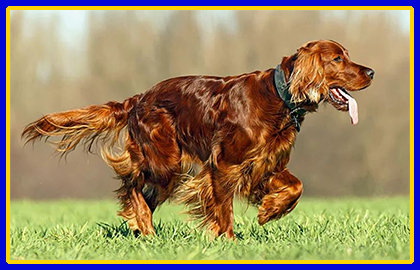
Two months’ work to do over again. It sets me back.
There was no other draft. I was pretty mad,
but the poor little fellow may have been acting critically.
I didn’t want to ruin a good dog on a manuscript
that I’m not sure is good at all.
He only got an ordinary spanking
with his punishment flyswatter.
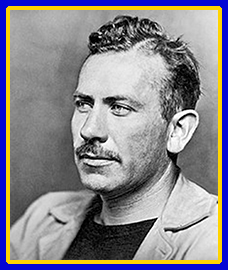
John Steinbeck
(1902-1968)
American novelist
regarding the destruction of Of Mice and Men
The King is Dead! Long Live the King!
Sir Walter Raleigh
Well, he wasn’t a king, but he was an amiable lord of his neighborhood realm. A few weeks ago, Sir Walter Raleigh died of old age. He was a 14-year-old beagle whose cheerful disposition guaranteed friendship with everyone he met, human or canine. He lived with an elderly lady about a mile and a half away. Most mornings when I went out for my walk, I would see the two of them strolling along.
When we’d meet, I’d ask Raleigh if he had a story for me. With tail wagging vigorously, he would raise his head and tell me one. It usually went like this: “yo yo yo yo yo yo yo yo …” articulated as only a beagle can. To his delight, I’d scratch his ears.
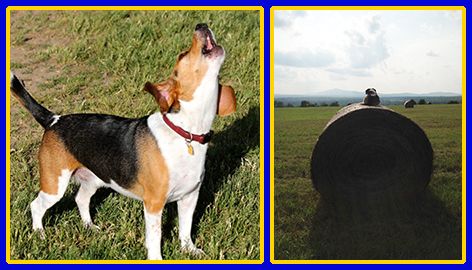
I couldn’t resist including this photo of Sophie, another old beagle from northern Maine who appears quite content to view her domain from the top of a bale of hay (with Mount Katahdin in the distance). I think she and Sir Walter Raleigh would have been good friends.
The joy that dogs express over the simplest things is a wonder to behold.
First Lady of the Seeing Eye
In my childhood, most of my reading was about horses, dogs, and animals in general – a lot of the obvious titles like Black Beauty, Beautiful Joe, the Uncle Wiggly series, the Thornton W. Burgess series, Red Fox, White Fang – you name it. Another title, a perennial in my mind, is First Lady of the Seeing Eye, by Morris Frank, a Tennessee native. While a child, Frank lost his eyesight in two separate accidents. In 1927, from an article in The Saturday Evening Post, he learned about the development of a school in Germany training dogs to assist blind WWI veterans. The author of the article, living in Switzerland, was broadening the reach of the program. Frank corresponded with her, and she encouraged him to come to Switzerland to train with a guide dog at her new school. Frank went in early 1928 and came home four months later with a female German shepherd named Buddy.
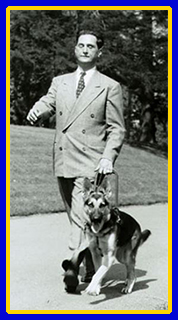
One scene has been etched in my mind ever since. Frank had been working with Buddy for some weeks. The trainer decided it was time to see how Frank and Buddy worked together, independent of the trainer. Frank and Buddy headed downtown on the sidewalk, with the trainer following at a distance to observe. Partway through the expedition, Buddy made a right turn, then an immediate left turn, proceeded straight for several steps, then made another left turn and an immediate right turn. Frank called back to the trainer: “Why did Buddy make those turns? What was she avoiding?” The trainer called back: “I can’t believe what I just saw! She spotted an overhead awning and didn’t know if you were too tall for it, so she detoured around it. She hasn’t had any training yet to assess overhead obstacles.”
Frank and Buddy brought the Seeing Eye Dog program to the States, incorporating the first school here in 1929. The two of them traveled all over North America, promoting and fighting for the rights of the blind to keep their dogs with them in any public facility, including airplanes, railroad cars, buses, hotels, and restaurants. It took time to overcome legal and cultural obstacles, but by 1956, such guide-dog accessibility to public spaces was universal across the country.
K-9 Officers
Since embarking on my project to write about police families surviving line-of-duty deaths, I’ve become more interested in K-9 police officers, too. Active-duty military and law enforcement dogs have been commissioned officers for many years; I’m still trying to find out just when such commissions were established for dogs – different times in different departments, agencies, and states. The deep bond that Hearne (above) talks about is crucial between a human officer and his or her canine partner. It goes beyond a working relationship – ultimate trust between human and dog is a must, on which their safety and survival rest. I’ve noticed this between human partners – a slight hand signal or a grunt, and the other officer knows exactly what the first officer wants done. It’s even more subtle between a human officer and a canine one.
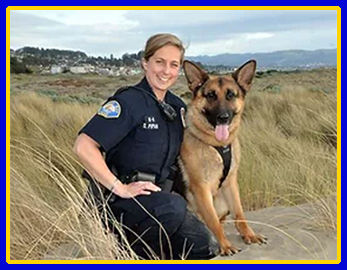
Police dogs receive extensive training in obedience, off- and on-leash behavior, evidence searching, tracking, clearing of buildings, apprehension, locating corpses, scent discrimination, narcotics and explosives detection, open-area searches, and patrolling.
The discernment required of the canine officer is learned through training and through hands-on (or paws-on) work. It’s quite clear that trained canines are capable of making shrewd judgments in rapidly changing situations.
April is National Canine Month, which celebrates our K-9 officers. Every May, the National Police Dog Foundation (https://www.nationalpolicedogfoundation.org/) honors LODD (line-of-duty death) canine officers with a memorial service during National Police Week in Washington, DC, a week-long event attended by tens of thousands of law enforcement personnel from all over the world.
Sheep Dogs
Sheep dog relationships aren’t much different from police dog relationships. Humans have developed several breeds with a genetic propensity for cooperative and collaborative herding – other livestock as well as sheep – with their human partners.
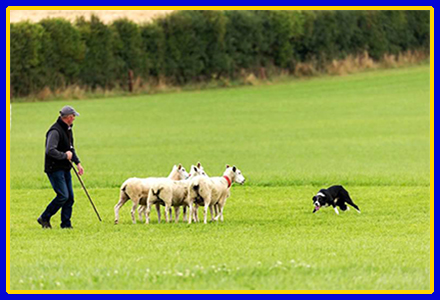
Border collies are particularly obvious in this skill, although several other breeds are just as capable. Again, the shepherd’s call, hand signal, and whistle are all that his dog needs to know which direction to drive the sheep, when to block them, when to nip at their heels, when to bark at them – any number of actions that get desired results. Again, the shepherd and the dog share a unique bond, a camaraderie. Each serves the other. It’s symbiotic.
Snookie (his unusual qualities and abilities)
In early 2006, four-year-old Snookie joined our family “pack.” He was medium-sized, with very soft, fine curly hair, with long poodle legs, body, and neck, and a cocker spaniel face, snout, and ears. He was swift and nimble and would have made a great circus dog or agility competitor. He was unusual, too, in that he rarely farted. He surprised himself on those rare occasions, and would whirl around to see what or who the intruder was.
Poodles are highly intelligent dogs; Snookie did not disappoint. While on the leash, he never went on the wrong side of a pole or post. He never let the leash catch under his legs. He never messed with toys that weren’t his, despite the population of teddy bears in our house (although he did make off with Phillip’s Grinch when it was obvious, a week after Christmas, that Phillip wasn’t going to play with it, so why couldn’t he have it?).
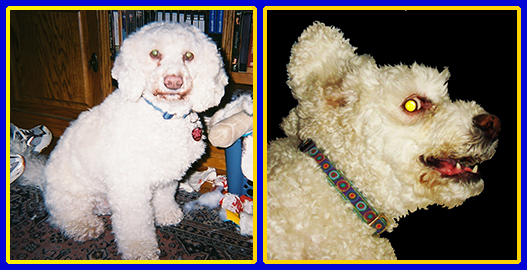 Demented Demon Dog:
Demented Demon Dog:
how people NOT in Snookie’s pack saw him
When Snookie was fairly new with us, Phillip’s sisters came over one Saturday evening to play board games. We set up one of those answer-question-to-move-piece games. While we played, the dog kept throwing balls at us, to get us to play with him instead. He was annoying. I said, “Let’s sit him up here at the table with us, so he’s included.” I set another chair next to me and he jumped up onto it. The game was for six players and there were only five of us, so we placed the sixth playing piece in front of Snookie. He acknowledged it with a sniff. Then we resumed play. It was my turn to answer a question. Phillip pulled a card and read the question to me. “WOOF!” Snookie proclaimed loudly. I turned to him and said, “It’s not polite to give away the answer when it’s not your turn.” He looked me in the eye for a long moment, then never said another word for the rest of the game.
Snookie wasn’t a noble creature in the sense of public duty and honor, but with his antics, he provided much comic relief after a day’s work. And that was duty enough. Seven years gone now, and I still miss him.
I could go on for pages with Snookie stories, but those should wait for another day. You dog owners have unique stories about the canine personalities in your lives, equally entertaining and uplifting, some of which reveal the inner depth of dogs. Aren’t we blessed?
A Book Worth Checking Out
 (Five Editors Tackle) The 12 Fatal Flaws of Fiction Writing
(Five Editors Tackle) The 12 Fatal Flaws of Fiction Writing
by C. S. Lakin, Linda S. Clare, Christy Distler, Robin Patchen, and Rachel Starr Thomson (all of whom are novelists, too)
The Writer’s Toolbox Series, Ubiquitous Press, Morgan Hill, CA (2015)
I find this book particularly insightful, as I work with my own writing and as I edit my clients’ work. I’m recommending it to my clients, too, so they can develop their work more before handing it over to me (less work and budget-friendly!). Writers of every skill – newbies, old pros, and everyone in between – will find much value in it, not only for fiction but also for non-fiction genres.
The book is not about rules and standards, but about concepts of storytelling. For isn’t that what we are doing when we write? In order to attract and interest a readership, we must tell a story that shows a tangible change in the characters, as they work through the storyline to achieve their goals. Whether it’s a murder mystery, a memoir, or a scientific report on mushroom species thriving inside the cone of an active volcano, it’s a story.
The book is packed with dozens of before-and-after examples, exercises for individual practice, and a summary checklist for each “flaw” chapter. I recommend it to anyone working on personal or professional writing projects.
Calendar & Announcements
Nothing literary to note this time, but here’s some family-friendly musical fun instead.
April 14, 2024 – Sunday – Lincoln Salute Fife & Drum Concert
Pearce Park, 17 Weston Road, Lincoln, MA
1:00 pm – 3:00 pm
Free; open to the public. Bring a picnic and blankets or lawn chairs.
Eight fife and drum corps perform music from periods of American history, to celebrate the events occurring during April 1775, lighting the spark that ignited the American Revolution. My corps, The Musick of Prescott’s Battalion, is one of the corps performing.
May 3, 2024 – Friday – Tattoo on Lexington Green
hosted by the William Diamond Junior Fife & Drum Corps
Lexington Battle Green, 1625 Massachusetts Ave, Lexington, MA
7:00 pm
Free; open to the public.
Music from periods of American history. Performances by four corps: William Diamond Junior Fife & Drum Corps, Connecticut Patriots Fife & Drum corps, Stony Creek Fife & Drum Corps, The Musick of Prescott’s Battalion.
May 4, 2024 – Saturday – 22nd Annual Fife & Drum Muster
hosted by the William Diamond Junior Fife & Drum Corps
Hastings Park, 3 blocks west of Lexington Green, on Mass Ave, Lexington, MA
10:00 am – 4:00 pm
Free; open to the public. Bring a picnic and blankets or lawn chairs.
Music from periods of American history. Performances by 30 corps from all over the Northeast.
Sources
Image: dog and chick
https://www.dogster.com/lifestyle/best-farm-dogs
Image: John Steinbeck
https://en.wikipedia.org/wiki/John_Steinbeck
Image: Irish setter
https://www.dailypaws.com/dogs-puppies/dog-breeds/irish-setter
Image: baying beagle
https://moderndogmagazine.com/entry/sam-21977/
Image: Morris Frank and Buddy
https://www.seeingeye.org/
Image: human & canine police officers
https://www.nationalpolicedogfoundation.org/
Image: working sheep dog
https://www.farmersjournal.ie/watch-national-sheepdog-trials-2015-187699



